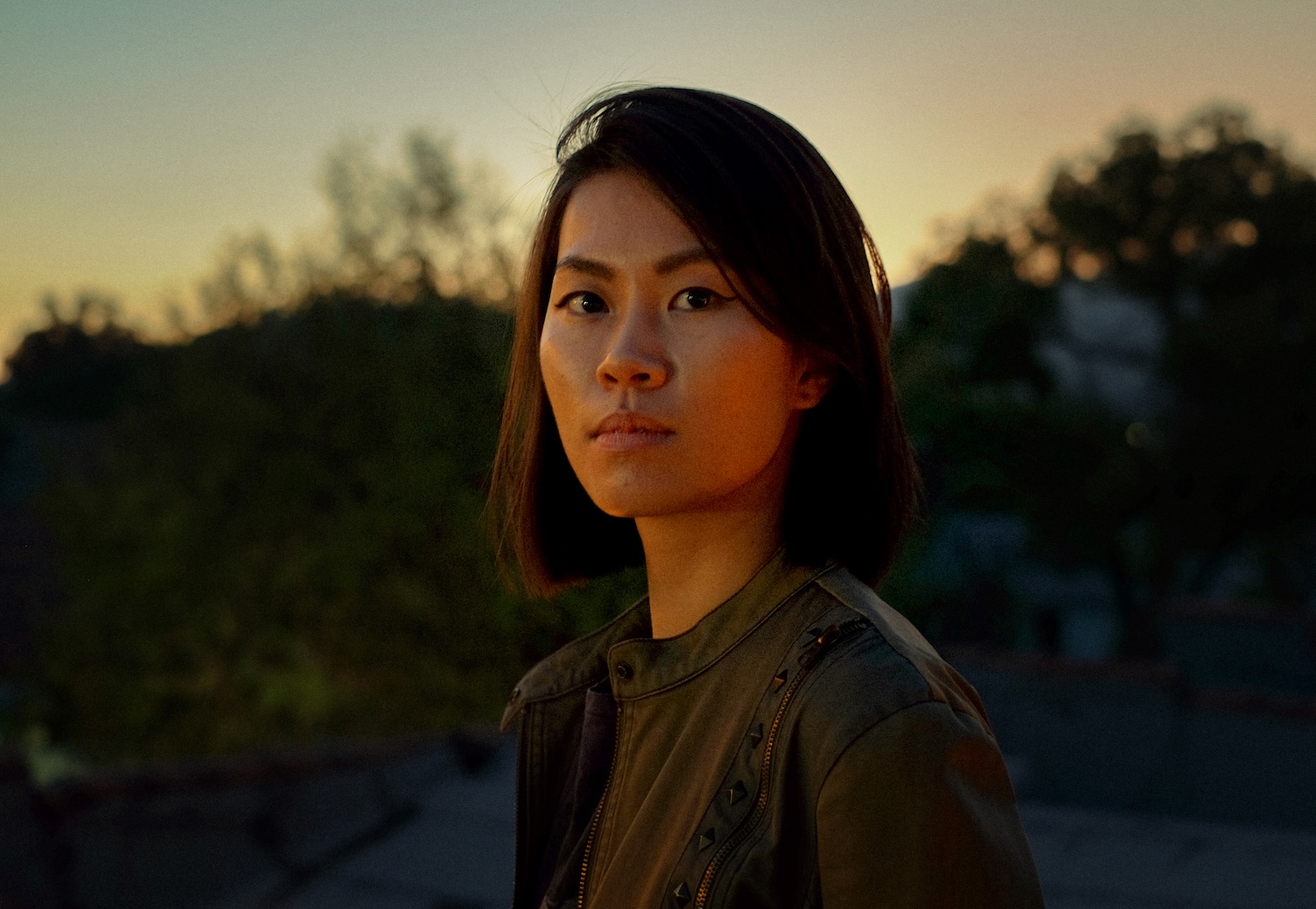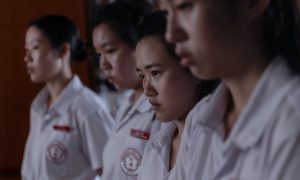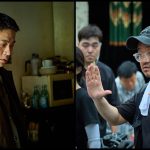
Filmmaker Siyou Tan marks her feature debut with Amoeba, a coming-of-age tale set in her native Singapore. Four teenage girls find friendship through rebellion against their country’s authoritarian system. All students at the Confucian Girls’ Secondary School, they refuse to play by the rules forced upon them. Or at least they mostly do, though eventually the reality of future prospects intrudes upon their self-described gang. It’s a moving examination of youth and agency. The movie just premiered at the 2025 Toronto International Film Festival, where I reviewed it and had the chance to sit down with Tan for an interview. Here is that conversation, edited for length and clarity.
Hammer to Nail: In your own words, please explain what your movie is about.
Siyou Tan: Amoeba is about a group of teenage girls in an all-girls school in Singapore that try to form a gang.
HtN: In the press notes, you talk about how your inspiration for this film comes from your own experiences growing up in Singapore. While I understand that this is not an autobiography, what elements from your own life remain in the script?
ST: I need to turn back the wheels of time. The film is very personal and started from an extremely personal place. I went to an all-girls school, middle school, and I had a group of friends that were fellow rebels. And the school I went to was also very Chinese-style, which is represented in the film. And I would have to say that actually it’s all a little bit topsy-turvy. What seems real is fake and fictionalized and what seems fake is real. For example, the color of your bra had to be white and there were checks on it. That’s real, but it feels surreal. What else? Dragging your table into classroom feels like a fake thing, but it’s real. I had to do that in my new class. And the things that seem real were fictionalized, like the cave and the friendship dynamics. The characters became more fictional. I wanted to make them more multidimensional, so I had to think of them as characters in the story in a way and how they relate to each other and think about the character relationships. The ghost is also real.
HtN: I was going to ask you about the ghost! So, your main character sees ghosts in the film or at least claims that she does. Have you seen ghosts?
ST: Have I seen ghosts? I have not seen a ghost because they don’t appear visibly to me, but I have felt them, and maybe you would think I’m crazy, but I think they exist and I feel them very, very tangibly around me. There was a ghost in my childhood bedroom, which terrorized the shit out of me, and it was a bit of a turning point for me in my life because I remember that I was terrified the first time it happened. But also, I liked to stay up at night when I was a teenager to chat with friends on IRC, and that’s when the ghost appeared the first time. And I told my mother about it, and she told me that there’s no such thing in our house. And I don’t know, as a teenager, I felt silenced and I realized I couldn’t go to my parents for comfort because they only wanted to hear the things they wanted to hear and if things were unpleasant, there was no mention of it.
And there was a moment where I then went to school and my friends were like, “What’s up? What’s wrong?” And I said, “I think there’s a ghost in my room,” and everyone chimed in. Everyone came to help me with all sorts of things like prayer cards and chants and everything. And several friends also were like, “Oh yes, I’ve seen a ghost before, too.” So that was the first encounter and the ghost stayed in my room. And actually I have to share that I feel a sense of affirmation because last year my younger sisters were just casually mentioning, “Oh yeah, I remember the ghost in your room.” And I was like, “You knew about the ghost in my room?” So everyone knew about the ghost in my room, but nobody talked about it.

Chris Reed and Siyou Tan
HtN: Your main character, Choo Xin Yu, delivers this really beautiful speech at the end of the movie asking, “How do we get out of this aquarium,” referring to Singapore or the community in which she lives as an aquarium. Is that how you saw Singapore growing up, as sort of this enclosed, hermetic society?
ST: Well, as a teenager, I don’t think I could articulate it in any way. It was just a feeling I felt of it being in a very stifling environment. I think I felt that I couldn’t be myself. And of course, it’s also my family’s circumstances. My parents are very, very strict. So it happened that the schools I went to were very strict and I felt the need to hide myself a lot and didn’t feel very free. So I think now that I’m an adult and I live in the United States, looking back, I do feel that Singapore is hermetically sealed and it’s a little bit narrow-minded in a sense that it’s a small, relatively wealthy country that has been controlled very much by the powers and people are not even aware of how much control they are subjected to. I feel that it’s a bit of a carrot and a stick thing. It’s like you’re given a certain amount of standard of living and a comfortable life, but what do you give up in return for that?
HtN: I understand. Do you think that the country has changed at all since the time of your adolescence or what you represent in the film?
ST: That’s an interesting question because I think, cosmetically, there are a lot of changes. I mean, we’re sitting in Toronto, and I hear a lot about people saying how Toronto has changed its skyline, with a lot of new buildings. I think cosmetically, Singapore has changed very, very, very rapidly, with new buildings that are taller and more modern. So, those things have changed. And when I go back to Singapore, it keeps changing. It’s very surreal. The places that I remember are not there anymore. But underneath it, I think the psychology of it has not really changed.
But I’m just going to speak more to the teenage growing-up kind of thing because I lived there until I was 17. And through the casting process, I spoke to many young people and I feel that the pressures are very much the same. Pressures from school, from parents, from society, expecting you to be a certain way, expecting you to grow up, to be a responsible adult, have a job, and buy a place, get married, have children. It’s like all the same things. And in a way, even though they have social media, they can express themselves a little bit more, but I think they feel the pressure more even than I did because the country has just gotten taller and more stressful. At least when I was growing up, there was a little bit more mess involved.
HtN: I love your cast; they’re really very strong. You’ve got Ranice Tay in the lead and then Nicole Lee Wen, Lim Shi-An and Genevieve Tan. Not to mention Jack Kao, who’s a well-known face. Could you describe how you went through this process of casting?
ST: I love casting. I think casting is very important, especially for this film. When I went into it, I thought that the cast was the most important thing in the film. You need to believe the characters, you need to believe their chemistry, you need to believe they’re a group of friends. So we started really early, eight months before shooting, and I worked with a casting director, Shirmaine [Ong], who was with me on a previous short film. And after working on the short film, we became friends and we had the same taste and I truly was so happy that she came to be the casting director. And we searched, we did traditional casting on boards and Telegram and all that. We went street casting, we tried to go to schools, we did all sorts of nonsense, dug around.
And I had an idea that I would like to cast actual 16-year-olds, but that proved very difficult because the range of 16 to 19 are people who are in exams and casting them means casting their parents. And the parents were not very willing for them to do something as frivolous as a film. And I think most of them didn’t understand what a feature film entails. It’s not a short film. It’s not like you show up for two hours and you go home to take an exam, so I think after a couple of weeks we realized that we needed to seriously consider people older, in their twenties, and consider people who have a little bit of experience.

A still from AMOEBA
So, Ranice and Genevieve came from theater; it’s their first screen experience. And Nicole and Shi-An are screen actors; they’ve done some short films but this is their first feature film. Our casting was fun and we called them back in groups and we did a lot of improv games the first round. I also asked them to do self-tapes where it was nothing about acting. I just wanted to get to know them; I feel it’s important, because with actors who are less screen-trained, I think they bring a lot of themselves into the character, too. So I kind of wanted to get to know them a little bit, as well.
HtN: You’ll be happy to know, at least from my perspective, that they believably look as if they’re in high school. I don’t know if you had to change their hair at all so that they look more like teenage girls?
ST: Yes, but not for them to look like teenage girls, because luckily they look really young. When we photographed them, we were like, “What? They actually look 15, 16.” But Genevieve had long hair and I asked her if she would be willing to cut her hair and she did it. Her hair was long all the way to the end of her back and she did it.
HtN: How about Jack Kao?
ST: Jack Kao was a dream cast for me. I love Hou Hsiao-Hsien films and the way I approached the uncle character, in terms of casting, was that he had to be a little bit mythical, a little bit unreachable in a way, mysterious. And so I was always secretly hoping that it could be someone like Jack Kao, or Anthony Wong from Hong Kong, these gangsters of the screen; that’s their persona. And so we tried looking in Singapore and Malaysia, and one day I maybe mentioned Jack Kao to my producer and he was like, “Let’s try.” And I was like, “Oh, no way.” So we tried. We reached out to Jack through a Taiwanese producer and he was open, we spoke on Zoom. It was very surreal. And then he was like, “Yeah, I want to do it. If we can work out the dates, I’m coming.” And it was very surreal because he appeared and before that it was kind of just me and the girls and then Jack appeared and he’s like, “OK, it’s time to button up our shirts and get our act together.” No, just kidding. But he was so generous and so nice and so cool. I felt that it was kind of a nice fun thing to have in the middle of the shoot, as well.
HtN: Congratulations on that casting coup.
ST: Thank you.
HtN: So we talked about ghosts a moment ago, and I’m wondering about your choice to open with that somewhat degraded video and then we cut to a more traditionally beautiful shot after that. What led you to want to start your movie with this scene that might lead us to believe, “Oh, we’re watching a found-footage movie” and then we see that we’re not, we’re watching something else?
ST: The opening was a big question in the edit. And I have to say that in the script, the first scene was always the ghost. The way we shot it, though, when we pieced it together in the assembly, the footage that we shot on the Alexa just didn’t feel right to start the film. And so then we started going in the direction of starting with the school, but I felt that I didn’t want to start the film in this very cold and detached way. I want you to feel that maybe there’s something underneath this. So then the camcorder footage was something that I really wanted to play with a lot. We actually had four different camcorders and the night vision, black-and-white infrared camera.
I felt that when we watched it, it has such a special quality. It’s mysterious. You don’t know what you’re seeing. It’s a bit scary. But if you think about it, it’s just two girls in the room and they’re just filming themselves and it’s about seeing and it’s about not seeing but knowing it’s there. And it’s about this frisson between the two of them. And in a way, it’s also a bit about desire and how desire is something that you cannot see, but you can feel, as well. And the way we structured the film, the scene where this footage happens is in the middle. And it became a little bit of, “It’s not the point of the film, but it’s the secret of the film.” And I felt that I wanted to start the film on that tone of mystery and something lurking underneath, but also innocence, and let it color your viewing of the school.

A still from AMOEBA
HtN: I’m glad you mentioned desire because there’s definitely an undercurrent of tension between the girls. That could be desire—you never spell it out—but it could be there, it could not. Speaking of the secret of the film, please explain the title, “Amoeba.”
ST: So, the title was one of the first things that started with this project because it’s kind of a personal thing. When I was growing up in Singapore, I went to a middle school that was like this Chinese school and I had many friends. We were very rebellious, with the usual pressures and stuff. And then me and my three friends all went to different high schools. And in the high school that I went to, it was a completely different environment. It was very kind of English-speaking and religious, a very Christian school. And I guess, as someone who was struggling in my sexuality, it was a very hostile environment. And I recall very distinctly that one day I was just thinking to myself, “I’m an amoeba.” The amoeba to me represented this idea of self-sufficiency. And it’s also a bit weird. It’s alone. It’s like swimming in this blobby water thing. It’s a bit off-putting, in a way. So I kind of took on this idea that I was an amoeba. It was a story I told myself to survive and to be okay with how withdrawn I had become. The film became a way to unpack and reflect on why I called myself an amoeba.
HtN: Thank you very much for sharing the film with the world and for sharing your story with me.
ST: Thank you, Chris!
– Christopher Llewellyn Reed (@ChrisReedFilm)











